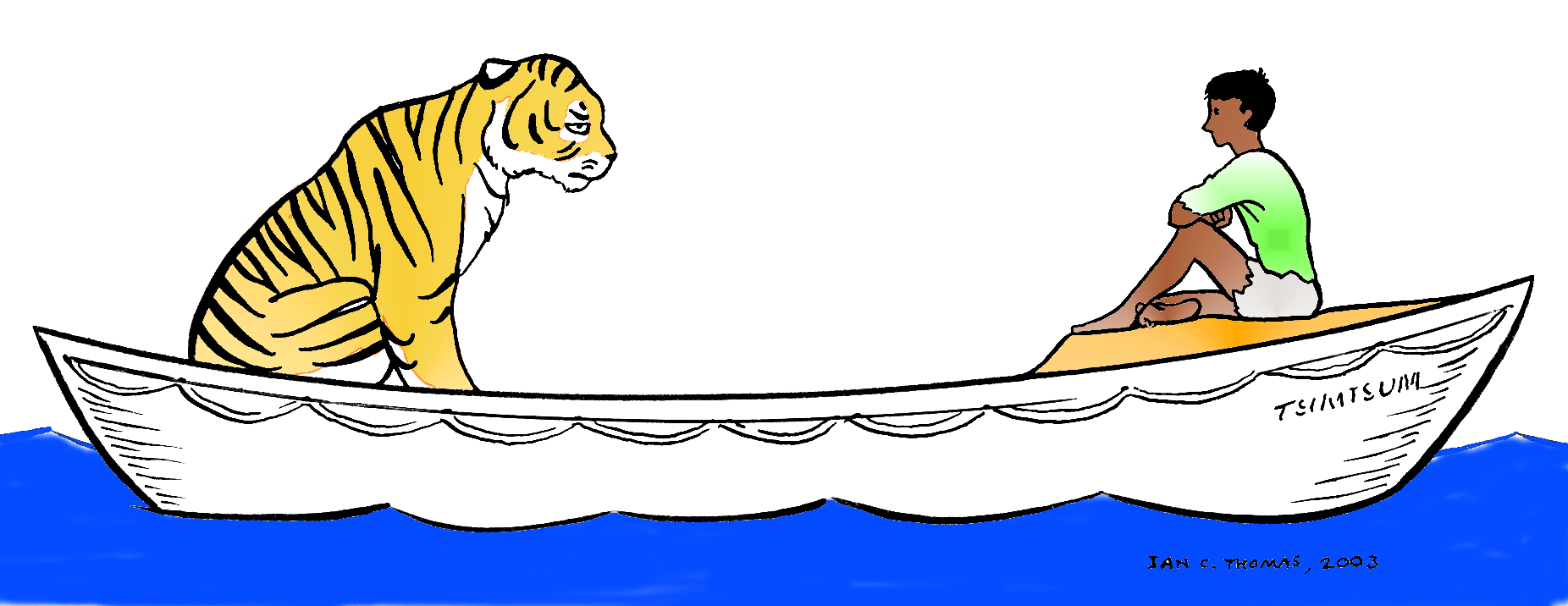Deja Views: Precedents in Art
The following essay started out as my musings on the Maelstrom page, about the relation of dwarfs in the works of Alan Garner (and Tolkien before him) to those in my own. With the recent explosion of genre fantasy writing, it may no longer need saying, but the tangent is a relevant one in all artforms!
 Easily the best book I've read this year (2003), is Life of Pi by Yann Martel. It justifiably won the Man Booker Prize. The fact that I was stuck by the originality of the concept is significant. When I first picked the book up, I was expecting it to be some sort of "talking animal" story, particularly as some reviewers referred to Kipling. Instead, it was something altogether different and brilliant.
Easily the best book I've read this year (2003), is Life of Pi by Yann Martel. It justifiably won the Man Booker Prize. The fact that I was stuck by the originality of the concept is significant. When I first picked the book up, I was expecting it to be some sort of "talking animal" story, particularly as some reviewers referred to Kipling. Instead, it was something altogether different and brilliant.
The main part of the story revolves around Indian teenager, Pi, adrift in a small lifeboat with an adult male Bengal tiger. A startling premise indeed!
However, controversy emerged when it was alleged that Martel had "borrowed" the premise from Max and the Cats by Brazilian writer, Moacyr Scliar, published in 1981. The major part of this book revolves around a boy sharing a boat with a jaguar.
To his great credit, Yann Martel has freely acknowledged the origin of his initial idea, thanking Scliar in the author's note to Life of Pi and repeatedly mentioned Max and the Cats in interviews. In fact, his success has in turn led many readers back to Moacyr Scliar's work.
My point is that all art has precedents and antecedents, though often unfortunately unacknowledged. For examples, think of the way that Maurice Sendak's In the Night Kitchen is a tribute to Windsor MacKay's Little Nemo, or the way The Alan Parsons Project uses that old r&b standard "Papa Was a Rolling Stone" as a production inspiration for part of the I Robot track, "The Voice." Both "borrowings" are freely admitted by the artists, as tributes to their inspirations.
Painters such as Manet have traditionally copied figures from earlier paintings or sculptures, in his case placing figures (including nudes) into contemporary settings, with controversial results. No painter, or musician, could seriously have existed without the preceding body of work, with its discoveries and invention.
For a prime pop culture example familiar to all, a good place to check out is StarWars Origins.
Again in pop culture, there's David Eddings and Lloyd Alexander to consider (Taran/Garion, Eilonwy/CeNedra, etc.): striking character and situation similarities! Also, Disney made a film of The Black Cauldron, which was quite a valiant attempt at a step foward at the time (though poorly received and failing to find much of an audience). However, for some interesting discussions regarding possible inspirations of more recent Disney films, these links are fascinating:
Atlantis and Nadia: Secret of Blue Water
The Lion King and The Jungle Emperor (AKA Kimba)
Like some others, I have to wonder about the similarities between the Chuck Jones animated film for Warner Brothers, Musetta or Gay Purr-ee (1962) and The Aristocats (1970), which it may have helped to inspire.
While these ideas may be more prosaic (particularly a talking cat Odyssey, with upper class female and alley-cat male), the failure to acknowledge sources, while legally prudent, can be worrisome. In the case of the source being buried in another culture, whether it be Japan or Brazil, it does seem that there is a moral onus on the creator of the new work to freely acknowledge their inspirations and influences (providing they are aware of them), as Martel has done.
The line between creative inspiration and plagiarism can be a fine one, but in closing I'll quote William R. Inge, "Originality is undetected plagiarism." It pretty much applies to all artforms these days!
The above is © Copyright, Ian C. Thomas, 2003 No reproduction without prior written consent and acknowledgment
Return to Ian
Thomas Graphics main page.
 Easily the best book I've read this year (2003), is Life of Pi by Yann Martel. It justifiably won the Man Booker Prize. The fact that I was stuck by the originality of the concept is significant. When I first picked the book up, I was expecting it to be some sort of "talking animal" story, particularly as some reviewers referred to Kipling. Instead, it was something altogether different and brilliant.
Easily the best book I've read this year (2003), is Life of Pi by Yann Martel. It justifiably won the Man Booker Prize. The fact that I was stuck by the originality of the concept is significant. When I first picked the book up, I was expecting it to be some sort of "talking animal" story, particularly as some reviewers referred to Kipling. Instead, it was something altogether different and brilliant.